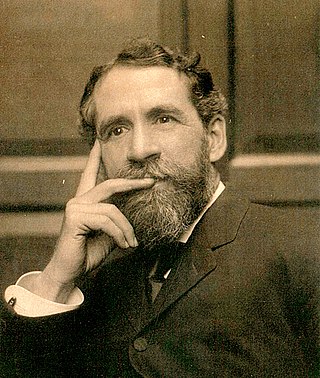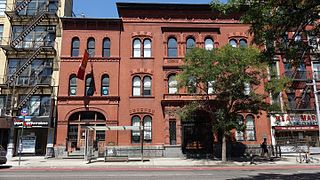
Cobble Hill is a neighborhood in the northwestern portion of the New York City borough of Brooklyn. A small neighborhood comprising 40 blocks, Cobble Hill sits adjacent to Brooklyn Heights to the north, Boerum Hill to the east, Carroll Gardens to the south, and the Columbia Street Waterfront District to the west. It is bounded by Atlantic Avenue (north), Court Street (east), Degraw Street (south) and the Brooklyn Queens Expressway (west). Other sources add to the neighborhood a rectangle bounded by Wyckoff Street on the north, Hoyt Street on the east, Degraw Street on the south, and Court Street on the west.

The Financial District of Lower Manhattan, also known as FiDi, is a neighborhood located on the southern tip of Manhattan in New York City. It is bounded by the West Side Highway on the west, Chambers Street and City Hall Park on the north, Brooklyn Bridge on the northeast, the East River to the southeast, and South Ferry and the Battery on the south.

The Wainwright Building is a 10-story, 41 m (135 ft) terra cotta office building at 709 Chestnut Street in downtown St. Louis, Missouri. The Wainwright Building is considered to be one of the first aesthetically fully expressed early skyscrapers. It was designed by Dankmar Adler and Louis Sullivan and built between 1890 and 1891. It was named for local brewer, building contractor, and financier Ellis Wainwright.

SUNY Downstate Medical Center is a public medical school and hospital in Brooklyn, New York. It is the southernmost member of the State University of New York (SUNY) system and the only academic medical center for health education, research, and patient care serving Brooklyn's 2.5 million residents. As of Fall 2018, it had a total student body of 1,846 and approximately 8,000 faculty and staff.

The Williamsburgh Savings Bank was a financial institution in Brooklyn, New York from the mid-19th to the mid-20th centuries. The bank was incorporated in 1851 under legislation passed by the New York State Assembly. The bank continued to operate until a series of mergers brought the bank into the HSBC group late in the 20th century.

William Bunker Tubby was an American architect who was particularly notable for his work in New York City.

University Hospital of Brooklyn at Long Island College Hospital was a 506-bed teaching hospital located in the Brooklyn Heights and Cobble Hill neighborhoods of Brooklyn, New York. The hospital was founded in 1858 as Long Island College Hospital and following years-long attempts to save it through mergers and property development, it ceased operations on August 30, 2014.

The Montague–Court Building is a 35-story, 462 ft (141 m) tall commercial office tower at 16 Court Street in Downtown Brooklyn, New York City. It was designed by architect H. Craig Severance and built in 1927. It is the tallest office building and the twelfth tallest building overall in Brooklyn at 462 feet. The building is 35 stories tall and has a floor area of 317,625 sq ft (29,508.3 m2). The Montague–Court Building has been owned and managed by the CIM Group since 2017, when CIM purchased the structure from SL Green Realty for $171 million. In February 2012, the New York City Landmarks Preservation Commission designated the building as part of the Borough Hall Skyscraper Historic District.

Village Preservation is a nonprofit organization that advocates for the architectural preservation and cultural preservation in several neighborhoods of Lower Manhattan in New York City. Founded in 1980, it has advocated for New York City designated landmark status for a variety of sites like the Stonewall Inn and Webster Hall. The organization and its Executive Director, Andrew Berman, have been described as influential in New York real estate, while some of its activities to prevent development and to support restrictive zoning have attracted criticism.

The Ottendorfer Public Library and Stuyvesant Polyclinic Hospital are a pair of historic buildings at 135 and 137 Second Avenue in the East Village neighborhood of Manhattan in New York City. The buildings house the Ottendorfer Branch of the New York Public Library, as well as the women's workspace The Wing within the former Stuyvesant Polyclinic hospital.

The Cobble Hill Historic District is a municipal and national historic district located in the Cobble Hill neighborhood of Brooklyn, New York City. The national district consists of 796 contributing, largely residential buildings built between the 1830s and 1920s. It includes fine examples of Greek Revival, Italianate, and Queen Anne style row houses. Also in the district are a number of notable churches, including ones by Richard Upjohn and Minard Lafever, 1851–52). A number of early 20th century apartment buildings are part of the district as well.

William Henry Herriman was an expatriate American art collector in Rome who, on his death, left important works of art to the Metropolitan Museum of Art in New York and the Brooklyn Museum.
William S. Herriman was a wealthy businessman who became President of Long Island Bank, the first bank in Brooklyn, New York. He remained in that position until his death when he was replaced by William C. Fowler.

The SUNY Downstate Health Sciences University is a public medical school in Brooklyn, New York City. The university includes the College of Medicine, College of Nursing, School of Health Professions, School of Graduate Studies and School of Public Health.

The Anne Kastor Brooklyn Free Clinic (Brooklyn Free Clinic or BFC) is a student run free clinic located in East Flatbush, Brooklyn, NY. Nearly all the positions from front desk administration and clinical volunteers to Executive Board are staffed by students from the various colleges of SUNY Downstate Medical Center.
Jeff Strabone is a Brooklyn-based American scholar, political activist and civic leader. In 2016, his website directelection.org listed the names and addresses of members of the U.S. Electoral College, and he urged people to write to electors to ask them not to vote for president-elect Donald Trump, an effort which brought him national attention. As a civic leader in Brooklyn, he has been active in promoting theatre preservation, building codes and housing issues, hospital preservation, and traffic flow. He has been a leader of Brooklyn's Cobble Hill Association, a neighborhood preservation group. He is the co-founder and chairman of the New Brooklyn Theatre.
Louis Kestenbaum is an American real estate developer who is the founder and chairman of New York City-based Fortis Property Group.
Victory Memorial Hospital was a 254-bed medical facility. It was announced in 2006 that they're closing; they were acquired by SUNY Downstate Medical Center in 2009 and renamed SUNY Downstate at Bay Ridge.















